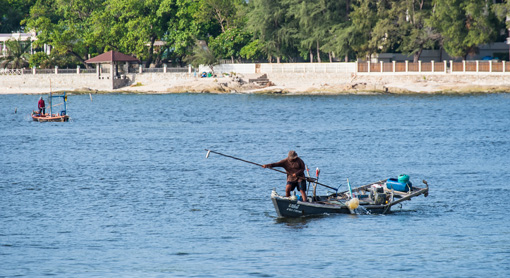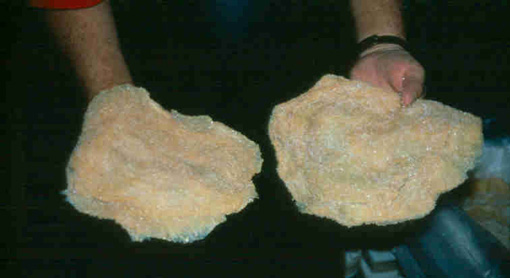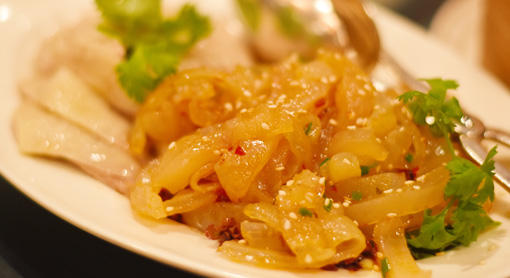Compared to the closely related corals, sea jellies have a bit of a poor reputation because they can sting people and affect coastal industries. But did you know that sea jellies benefit people in many ways, including as a source of food and through their contributions to medical science?
Fisheries for sea jellies
Sea jellies have been harvested in Asia for more than 1700 years but large scale commercial harvesting of sea jellies commenced around 1970. During the late 1990s the annual global harvest peaked at almost half a million tonnes. Most sea jellies are harvested in Asia but growing demand for jellies has seen small-scale fisheries emerge in regions such as Australia, the USA, the Middle East and Europe. Approximately 17 species of sea jellies are harvested for food. In Australia, the Blue blubber (Catostylus mosaicus) has been harvested in small quantities.
 Sea jellies being harvested in Thailand
Sea jellies being harvested in Thailand
 Dried sea jelly (Catostylus mosaicus), northern NSW, Australia. Credit, Kylie Pitt.
Dried sea jelly (Catostylus mosaicus), northern NSW, Australia. Credit, Kylie Pitt.
After harvesting, sea jellies are preserved by semi-drying them using a combination of alum and salt. The drying process can take 20-40 days and the dried product has a rubbery texture. Dried sea jelly is prepared for eating by rinsing it in copious amounts of cold water to remove the salt and partially reconstitute it. The sea jelly is then sliced into strips, blanched in boiling water and mixed with sauces and other ingredients such as chicken or seafood and served as a cold salad. When prepared the sea jelly resembles noodles that have a little bit of a crunch. Dried sea jellies are usually available for sale in Asian supermarkets or you might find them on the menu in Asian restaurants. You might like to try the following recipe for sea jelly salad:
Recipe for sea jelly salad
 Sea jelly salad
Sea jelly salad
- 1 packet of dried sea jelly
- 3 tablespoons of sesame oil
- 2 teaspoons of soy sauce
- 2 teaspoons of rice vinegar
- 1 teaspoon of white sugar
- ¼ teaspoon of chili oil
- 1 teaspoon grated fresh ginger
- 2 tablespoons sesame seeds, toasted
- 2 tablespoons of coriander, chopped
- 2 tablespoons green onion, thinly sliced
Rinse the dried sea jelly under copious amounts of freshwater to remove salt and slice into thin strips. Blanch the shredded sea jelly in boiling water and allow to cool. Whisk sesame oil, soy sauce, vinegar, sugar, chili oil and ginger together and mix through the shredded sea jelly. Stir in the coriander and spring onions and sprinkle with toasted sesame seeds.